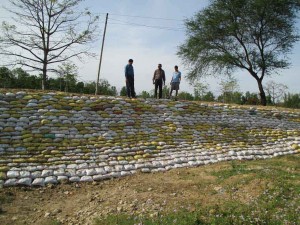Theme 5 Climate Change Adaptation and Disaster Risk Reduction
Background:
Nepal has tremendous geographic diversity. From as low as 59 meters above sea level in the tropical Tarai (the northern rim of the Gangetic plain) region, beyond the perpetual snow line to some 90 peaks above 7,000 meters including earth’s highest mountain peak, Sagarmatha (8,848 m), Nepal has contrasting landscapes. Nepal is divided into three belts: Tarai, Hill (Pahad), and Himalaya from south to north. It is divided into four major river systems from east to west: Koshi, Gandaki, Karnali and Mahakali. 17% of the total land of Nepal is occupied by Tarai belt and the remaining 83% are hills and Himalaya). Nepal is rich in bio and geographical diversities too. With the geographical diversity, different natural disasters also have of diverse nature. Every year Nepal is struck by different natural calamities since it has topographically dynamic mountain ranges, unbalanced deep slope land, and weak geological structure. Around 500 such disasters take place in Nepal every year that cause physical and infrastructure damages, loss of humans as well as property hindering the livelihood of Nepalese people. The Tarai and ‘Chure’ belts are vulnerable to floods, fires, drought, and epidemic; the hill belt is vulnerable to landslides, epidemic while Himal is vulnerable to avalanches, the blast of snow ponds, and snowfalls. Apart from that, all these belts of Nepal are also vulnerable to earthquakes because Nepal lies in a zone of high seismic activity. Besides these natural disasters, there is a vulnerability of human-made disasters too. The global climate change has also the effect in Nepal, change in monsoon pattern and the temperature goes high causes the floods, landslides, drought, fires, epidemic, etc which affect the agriculture production, employment, and indirectly harmful to the livelihood of people. About 65% agriculture of Nepal depends on rainfed while 75% population’s livelihood depend on agriculture. And the people dependent on agriculture have lack of information, knowledge and use of alternative technique and technology for agriculture production as per the situatuation of climate to cope with the climate change effect on food production. The farmers are facing the problem with their own way. The technology, techniques, and practices of most of farmers for agriculture production are traditional that is less effective for the the climate change adaptation.
Since the BASE has been working in the fields of disaster risk reduction and climate change adaptation for a long years, it works to equip people with knowledge, technology, techniques and mechanism at village. It also cunducts the policy advocacy to institutionalize the system for CCA and DRR in local, provincial and federal level governments to manage the distaster risk and climate change adaptation in line with the SDG 11: make cities and human settlements inclusive, safe, resilient and sustainable; SDG 13: take urgent action to combat climate change and its impacts; and GoN’s climate change adaptation policies.
Goal, objective, and strategy:
Goal:
To prepare communities and institutions to reduce the risk of disasters, by increasing awareness and equipping about disaster risk management and skills for climate change adaptation.
Objective:
- To raise awareness on disaster and climate change of 50 thousand people resided in areas of vulnerable to disasters.
- To prepare 20 thousand people resided in the possible disaster areas for disaster preparedness and 10 thousand people will have construction of disaster-resilient buildings.
- To support rehabilitation and immediate relief to 15 thousand households in case of disaster encounters.
- To raise awareness and alternative skills of 1500 village communities for climate change adaptation and long term recovery of disaster and climate change effects.
- To support to formulate the community based mechanism and strategies to respond disasters and to adapt climate change effect in 1500 villages, and build the capacity of the mechanisms.
Strategy:
- Coordinate and collaborate with all level’s disaster management and response committees, political parties, and organizations working in the disaster sector.
- Coordinate and mobilize traditional institutions like Mahatawa, Bhalmansa, Badghar and establish a disaster forecasting system.
- Transfer knowledge on disaster-resilient technology and skills; promote alternative energy and conduct awareness campaigns.
- Fundraising with coordination among federal, provincial, and local governments and international organizations and private sectors for immediate response and recovery.
- Develop coordination and collaboration with stakeholders to promote climate change adaptation tools and technology.
- BASE will continue working as a lead of the Asian Disaster Preparedness Plan (ADPC) and work with national and international networks working on climate change adaptation to bring new technology as well as to learn from them.
- Develop the disaster and climate change response institutions at villages and capcitate them in the DRR preparedness and CCA.



